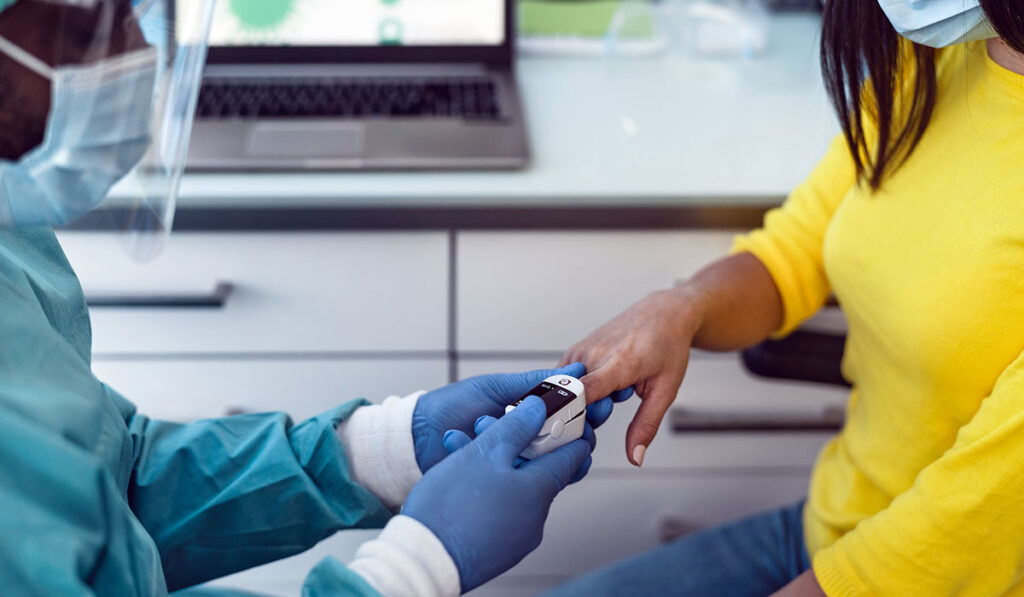A new observational study at Vanderbilt University Medical Center found that pulse-oximetry readings of patients with non-white skin may vary from commonly applied standards, raising concerns about a potential impact on critical care. The study is part of a continued focus at Vanderbilt on identifying and addressing disparities in healthcare.
The new study is a secondary analysis of the recently published PILOT (Pragmatic Investigation of Optimal Oxygen Targets) trial, which focused on oxygen titration in mechanically ventilated patients, and seeks to understand whether pulse oximetry is less accurate for patients with brown or black skin compared to white patients.
The laboratory blood gas (Sao2) test is considered oxygen titration’s “gold standard,” said Kevin P. Seitz, M.D., a clinical fellow at Vanderbilt and lead author of the study. Laboratory tests take time, however, “and sticking patients for arterial blood samples is painful,” he added.
The most common alternative is to use a pulse oximeter, which shines an LED light through the skin and provides a continually updated estimate of oxygen saturation. The device was widely introduced in the United States in the 1980s, and since that time some medical professionals have raised concerns about its accuracy for all patients, especially those with darker skin. As use of the devices became more common throughout the COVID 19 pandemic, further concerns were raised.
Impact Becomes Louder
A December 2020 letter to the New England Journal of Medicine by Michael Sjoding, M.D. and others from the University of Michigan Medical School, entitled “Racial Bias in Pulse Oximetry Measurement,” first alerted the medical community and the FDA to the seriousness of the issue.
Seitz explains: “Their research letter concluded that if a patient who is Black has a normal pulse oximeter reading, they are more likely than a white patient to have a dangerously low oxygen saturation when you measure it with a lab test.”
As a result, researchers began re-examining data to confirm the pigmentation effect and to understand what might be done about it.
“There’s obviously a focus on reducing disparities in medicine right now,” said Matthew W. Semler, M.D., an assistant professor of medicine and biomedical informatics at Vanderbilt and lead investigator on the PILOT trial.
“This is a project aimed at reducing disparities. The pulse oximeter has been used for years without widespread recognition that there might be different readings based on skin pigmentation. Vanderbilt is helping to identify that problem.”
Recalibrating
After examining data to confirm the pigmentation effect, researchers began considering what might be done about it.
“Perhaps we can just deliver more oxygen – aim for a higher target – for patients with more pigmented skin,” Seitz said. “But it’s also possible that the oximeter may be less accurate in both directions.”
PILOT data used in the observational study came from 1,024 patients who received invasive mechanical ventilation in the ICU at Vanderbilt, each monitored with the same type of pulse oximeter device, making the data more useful for comparisons.
The researchers compared multiple paired Spo2 (pulse oximeter) and Sao2 (arterial) measurements within a 10-minute window of time, with 70 percent of the comparisons made within one minute. Across the normal range of Spo2 values, which is between 92 and 98 percent, the associated Sao2 value was approximately one percentage point lower for Black patients compared to white patients. As a result, hypoxemia was slightly more likely to occur among Black patients with a normal Spo2 value compared to white patients with that same normal value.
“This is a project aimed at reducing disparities. The pulse oximeter has been used for years without widespread recognition that there might be different readings based on skin pigmentation.”
Conversely, oxygen levels that were too high, hyperoxemia, was also more likely to occur in Black patients whose pulse oximeter readings remained in the normal range. Semler says these variations could prevent timely detection of either low or high blood-oxygen levels.
Collaborations and Reassurance
“Because the pulse oximeter may be wrong in both directions, either too high or too low, adjusting the reported value for skin tone will not fix the problem,” Semler said. “Solutions are going to have to come from collaborations between academics and the industry that makes oximeters to figure it out by recalibrating the devices themselves.” The FDA and device manufacturers are currently plotting next steps, he added.
The PILOT trial results were able to reassure researchers that the range of oxygen saturation values noted are safe for all patients.
“We’ve done the research to be reassured that the clinical care we’re providing today using these devices is safe, but in the long run we need to make sure that these devices and all other treatments we use in healthcare are similarly safe and effective for all patients.”






